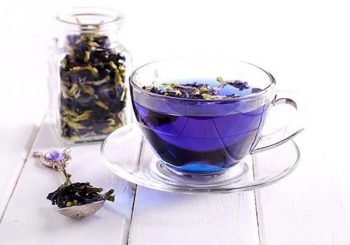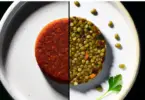Contributing writer for Wake Up World
Marcus Gavius Apicius, a Roman gourmand who lived during the 1st century A.D. and enjoyed all things luxurious, coined the phrase “We eat first with our eyes.”1 Indeed, many people are drawn to food and beverages that look delicious, interesting and unique, making it much more likely that you’ll savor them.
[pro_ad_display_adzone id=”110028″]
The same can be said for beverages, and one distinctive drink is making waves today because of its ability to change color, going from blue to pink to purple. It’s none other than butterfly pea tea. Discover more about this “magic” concoction and why, aside from its out-of-this-world appearance, it may have potential health benefits as well.
What Is Butterfly Pea Tea?
Known by many different names like blue-pea, bluebellvine, cordofan pea, Darwin pea2 and Asian pigeonwings,3 butterfly pea (Clitoria ternatea L.) is a plant from the Fabaceae (Leguminosae) or pea family.4,5 Its origins can be traced to tropical Asia, and through the centuries it was widely distributed in the West and East Indies, and then on to Central and South America, India and China.6
Butterfly pea is a climbing legume, with pinnate, alternately-arranged leaves composed of five to six oval leaflets, which are thin, papery and membranous. The slender stems of the plant are covered with short, soft hairs. The small flowers, which are beautiful and funnel-shaped, come in different colors including pink, white and dark blue.7,8 They resemble a woman’s genitals; hence, the botanical name.9
Different parts of the butterfly pea plant are known for being utilized in medicinal and culinary capacities. The fresh root is used in Ayurveda to help ease conditions like tuberculosis, ulcers and asthma. Root juice can also be ingested to help eliminate phlegm.
The leaves, on the other hand, are made into poultices to alleviate swollen joints. The flower is also popular in Thailand, Malaysia and Philippines as an edible food dye. The petals are used to garnish salads, ice cream and soups. The flowers are also brewed into tea.10
According to Bon Appetit, butterfly pea tea has a woody and earthy flavor that’s reminiscent of green tea. However, what’s most interesting about this exotic tea is its ability to change colors. The secret lies in its pH level — the drink changes color depending on the pH of any ingredient that’s added to it.
At its first brew, the beverage has a deep, midnight blue color. If you add a squeeze of lemon or any acidic liquid, it changes to a beautiful, rich violet. Add hibiscus flowers and the drink will turn bright red.11
In Asia, particularly in Thailand and Vietnam, butterfly pea tea is consumed regularly. It’s called “nam dok anchan”12 and is enjoyed as an after-dinner nightcap, or served as a welcome drink in spas and hotels. Thai restaurants also add it to puddings and “pulut inti,” a dessert made from glutinous rice and coconut.13
In the U.S., butterfly pea tea is gaining popularity in bars and restaurants, as it is often added to cocktails and other alcoholic drinks.14
Butterfly Pea Tea Benefits
While many enjoy it mainly for its lovely appearance, drinking butterfly pea tea may allow you to reap certain health benefits as well, because of the plant’s impressive properties. According to a study published in the Journal of Ethnopharmacology, butterfly pea is highly valued in Ayurvedic medicine and “has been used for centuries as a memory enhancer, nootropic, antistress, anxiolytic, antidepressant, anticonvulsant, tranquilizing and sedative agent.”15
Studies have highlighted the potential benefits of butterfly pea extract, which may be passed on to the tea:
•May have antidiabetic properties — A 2015 animal study published in the Journal of Applied Pharmaceutical Science has found that extracts from butterfly pea flower lowered serum glucose levels of diabetic rats significantly and increased their body weight. The antidiabetic effect was said to be comparable to the diabetes drug glibenclamide.16
•Has potential effects against stress and anxiety — A 2003 study published in the journal Pharmacology, Biochemistry and Behavior found that butterfly pea extract may have an effect on the central nervous system (CNS) of mice, and that it may particularly work against depression, stress, anxiety and seizures, and help improve cognitive behavior.
The researchers noted that “The extract exhibited tendency to reduce the intensity of behavior mediated via serotonin and acetylcholine.”17
•Helps curb hyperlipidemia, a risk factor of heart disease — A 2010 Pharmaceutical Biology study noted that ingesting butterfly pea extract (made from the plant’s roots and seeds) in combination with the herb Vigna mungo, led to a “significant reduction of serum total cholesterol, triglycerides, very low-density lipoprotein cholesterol, and low-density lipoprotein cholesterol levels.”18
The combination helped decrease dietary cholesterol absorption and prompted excretion from the body.
•Helps bring down fever — When given in doses of 200, 300 and 400 milligrams per kilogram, butterfly pea extract led to significant reduction in body temperature, which lasted for five hours after administration. This antipyretic effect was said to be “comparable to that of paracetamol.” These findings were published in a 2004 article in the journal Phytomedicine.19
Butterfly Pea Tea Nutrition Facts and Caffeine Content
A study found that petals of the butterfly pea flowers contain flavonol glycosides, mainly kaempferol, myricetin and quercetin.20 Other chemical constituents that contribute to the tea’s pharmacological effects include phenols, saponins, anthocyanins, flavanols and triterpenoids.21 And since it’s not made from the Camellia sinensis plant, butterfly pea tea is naturally caffeine-free,22 making it an ideal beverage for people with caffeine sensitivity.
How to Make Butterfly Pea Tea
Butterfly pea tea can be enjoyed either hot or cold. If you prefer a refreshing, icy drink that will quench your thirst during hot days, here’s an iced Butterfly Pea Tea recipe from the blog Kirbie’s Cravings:23
Refreshing Iced Butterfly Pea Tea Recipe
Ingredients:
- 2 cups boiling water
- 6 teaspoons butterfly pea tea
- Juice of a medium lemon
- Honey to taste
- Ice
Procedure:
- Add hot water to the leaves and cover to retain the heat. Let steep for several minutes or until the water is a deep shade of blue.
- Stir in lemon juice and add honey to taste. Serve with ice.
Note: You can remove the tea leaves or leave them in the brew.
Butterfly Pea Tea Side Effects
While there are no side effects reported to the butterfly pea flower and dyes made from it,24 the book “Home Remedies,” notes that herbal preparations using the leaves and powdered seeds of the plant may lead to severe nausea and diarrhea.25 Should this occur when you drink the tea, stop and consult your physician immediately.
If you have a health condition or are taking certain medications, it’s advisable to get approval from your doctor before drinking butterfly pea tea. Pregnant and breastfeeding women should also avoid consuming this beverage, as studies about its effects for these groups are still lacking.
Have A Colorful Cup Of Butterfly Pea Tea Today
The magical, color-changing properties of butterfly pea tea may have drawn you to try it, however, there’s more to this tea than its mesmerizing appearance and refreshing flavor. Its host of beneficial nutrients may have potential effects on your health, too. Brew yourself a cup of butterfly pea tea today.
Frequently Asked Questions (FAQs) About Butterfly Pea Tea
Q: What does butterfly pea tea taste like?
A: The flavor of this tea is described to be reminiscent of green tea, as it is woody and earthy.
Q: Does butterfly pea tea have caffeine?
A: Because it’s not made from the Camellia sinensis plant, this floral tea has no caffeine.
Q: Where can you buy butterfly pea tea?
A: Butterfly pea tea can be purchased online or from health food stores. Make sure to check the manufacturer to ensure you only buy a high-quality brand.
Sources and references:
- 1 Brain and Cognition, December 2016, Volume 110, pp 53-63
- 2 U.S. National Plant Germplasm System, Clitoria ternatea L.
- 3, 4 USDA Natural Resources Conservation Service (NRCS), Clitoria ternatea L.
- 5, 7, 8 National Parks, Flora and Fauna Web, Clitoria ternatea L.
- 6 In Vitro Cellular & Developmental Biology. Plant Vol. 43, No. 2 (Mar. – Apr., 2007), pp. 144-148
- 9 “21st Century Homestead: Nitrogen-Fixing Crops,” 2016
- 10, 24 “The Encyclopedia of Herbs and Spices,” 2017
- 11, 13, 22 Bon Appetit, January 31, 2016
- 12 “Thailand’s Best Street Food,” 2015
- 14 The New York Times, June 30, 2016
- 15 Journal of Ethnopharmacology, 8 December 2008; 120(3): 291-301
- 16 Journal of Applied Pharmaceutical Science, August, 2015; 5(08): 131-138
- 17 Pharmacol Biochem Behav. 2003 Jun;75(3):529-36.
- 18 Pharm Biol. 2010 Aug;48(8):915-23.
- 19 Phytomedicine, 2004; 11(4): 323-326
- 20 Phytochemistry, January 2003; (62)2: 229-237
- 21 IOSR Journal Of Pharmacy, March 2016; (6)3:68-83
- 23 Kirbie’s Cravings, November 7, 2016
- 25 “Home Remedies Vol. 4,” 2003
Originally published at mercola.com and reproduced here with permission.
Recommended articles by Dr. Joseph Mercola:
- Mind to Matter: How Your Brain Creates Material Reality
- Breathwork Helps Tame Stress, Benefits Mind and Body
- More Evidence Supports Benefits of Medicinal Mushrooms
- Practicing Gratitude During the Covid 19 Pandemic
- Here’s What You Should Know About Pumpkins
- Drinking Green Tea, Coffee Linked to Lower Mortality
- The Interconnectedness Between Anxiety and Inflammation
- What Can Olive Leaf Extract Do For You?
- Beets for Better Lung Efficiency
- The Little Known Sordid History of Psychiatry
About the author:
Born and raised in the inner city of Chicago, IL, Dr. Joseph Mercola is an osteopathic physician trained in both traditional and natural medicine. Board-certified in family medicine, Dr. Mercola served as the chairman of the family medicine department at St. Alexius Medical Center for five years, and in 2012 was granted fellowship status by the American College of Nutrition (ACN).
While in practice in the late 80s, Dr. Mercola realized the drugs he was prescribing to chronically ill patients were not working. By the early 90s, he began exploring the world of natural medicine, and soon changed the way he practiced medicine.
In 1997 Dr. Mercola founded Mercola.com, which is now routinely among the top 10 health sites on the internet. His passion is to transform the traditional medical paradigm in the United States. “The existing medical establishment is responsible for killing and permanently injuring millions of Americans… You want practical health solutions without the hype, and that’s what I offer.”
Visit Mercola.com for more information, or read Dr. Mercola’s full bio and resumé here.
[pro_ad_display_adzone id=”110027″]








